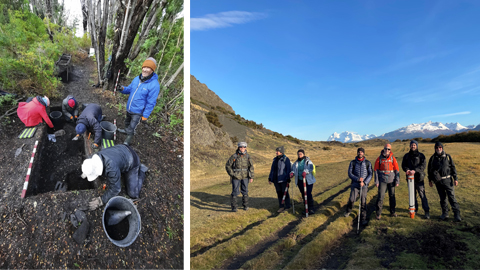Archaeologists from the UAB, the University of Magallanes and the University of Evora are conducting a project in the inland sea of Última Esperanza (Magallanes, Chile) to reconstruct the ancient history of hunter-gatherer groups inhabiting this region during the Late Holocene, a period rarely studied until now. The research, which is still in the analysis phase, has already revealed differences in the patterns of land and natural resource use between the areas studied, as well as documenting a possible "Indian passage".

The inland sea of Última Esperanza is located in the Tierra del Fuego archipelago, an extensive and rugged seascape inhabited by the southernmost human populations since at least 6,500 years ago. The groups of populations of this sea, which have been investigated so far on very exceptional occasions, lived as hunters-fishers-gatherers whose life was based on the resources of the sea and characterised by a high mobility on their canoes, a fact for which they are called canoers.
The project "Archaeology in the inland sea of Última Esperanza (Magallanes, Chile): navigation, exchange and use of the native forest during the Late Holocene" aims to reconstruct the ancient history of these canoeing communities and understand the different social, economic and mobility strategies they developed during thousands of years. It is led by a research team of the UAB Department of Prehistory formed by Albert García Piquer (Maria Sklodowska-Curie researcher), Robert Carracedo (Margarita Salas researcher) and Raquel Piqué (Icrea Acadèmia researcher), alongside Alfredo Prieto from the University of Magallanes, Chile, and Vanessa Navarrete, researcher of the Hercules Laboratory of the University of Evora, Portugal. The project receives funding from the Spanish Ministry for Culture, the Palarq Foundation and the Wenner-Gren Foundation, and also received support from the Fundación Prisma Austral.
For three years, researchers have been carrying out several archaeological campaigns, the last of which finished in April. Altogether, they studied different sectors of the Almirant Montt gulf and the Diego Portales island, the largest in the inland sea of Última Esperanza. They also conducted research on the mainland coast of Puerto Pratt, the coasts of the Antonio Varas peninsula, Guanaco Island and the islands and coasts of Worsley Sound.
The project, still in the analysis phase, has revealed differences in the patterns of use of the territory and natural resources between the island of Diego Portales, with a recurrent occupation near the beach and large deposits of shellfish and other foodstuffs, and the Antonio Varas peninsula, where a smaller presence of shellfish was detected, as well as lithic carvings, tanks for fishing and hunting of South Andean deer and scorching marks on trees at a considerable distance from the coast, possibly for the production of canoes. Researchers also documented a possible "Indian passage", a land route to cross the peninsula on foot and quickly access the mainland coast.
Both campaigns carried out so far and future work should allow archaeologists to define and specify the antiquity of the population in the area, seasonality, subsistence and mobility strategies, the use of forests and the construction of canoes, as well as the study of the "Indian passage" and the search for ritual sites.
The project is the result of an international cooperation between the University of Magallanes (Punta Arenas, Chile) and the UAB, and includes the participation of researchers from the Hercules Laboratory of the University of Evora (Portugal), Washington State University (USA), Austral Centre for Scientific Research (CADIC-CONICET, Argentina), Austral University (Chile), as well as students from the Universidad Católica de Santiago de Chile and the UAB.






